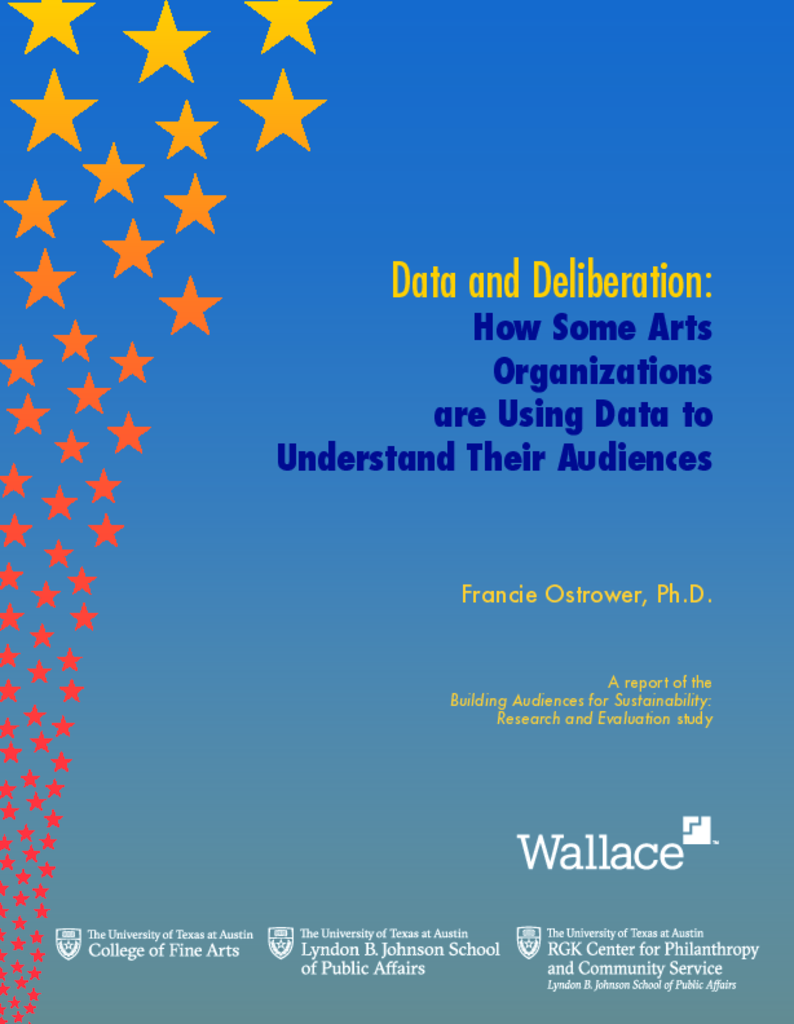Breadcrumb
- Wallace
- Reports
- Data And Deliberation How Some A...
Data and Deliberation
How Some Arts Organizations are Using Data to Understand Their Audiences

Summary
How we did this
This brief is based on interviews with leadership and staff of organizations participating in the Wallace Foundation’s Building Audiences for Sustainability (BAS) initiative. It shares interim findings about BAS participants’ experience implementing one key and crosscutting part of the initiative – the use of data and market research.
National statistics show stagnant or declining attendance across many forms in the arts. How can arts organizations use data and market research to cultivate new audiences and strengthen bonds with current attendees?
From 2015 to 2019, the Wallace Foundation awarded nearly $41 million in grants to 25 nonprofit performing arts organizations as part of its Building Audiences for Sustainability initiative. The goal of BAS was to engage new audiences while retaining existing ones. The initiative also sought to understand whether audience-building efforts contributed to organizations’ financial health.
Assessing the Use of Data for Audience-Building
This brief by Francie Ostrower, Ph.D., offers helpful insights on how arts organizations can use data and market research to cultivate new audiences and strengthen bonds with existing ones. It highlights the experiences of the 25 performing arts organizations participating in the BAS initiative. All used data collection and market research to support their audience building efforts. These approaches included focus groups, ticketing database analyses, and post-performance audience surveys.
These were not standalone activities. The BAS initiative emphasized data and market research as part of a continuous learning approach. This iterative process consisted of design, implementation, and analysis. It also included identification of changes needed for improvement.
Through interviews with organizations' leaders and staff, Ostrower found that data was not a magic bullet for audience building initiatives. It is a complex, challenging, and expensive undertaking. Compiling data without a clear purpose can produce an overload of information. Poor quality data can also hinder progress.
Despite these challenges, organizations found the focus on data and market research useful. In interviews, they shared that data prompted them to recognize and question assumptions. It helped them better understand their external environment. And it helped them communicate with audiences more effectively. What's more, they found that data can also point to programming options which are inconsistent with mission.
The literature on audience building suggests that performing arts organizations today face a potential loss of relevance, but do not understand the extent of the problem. Engaging with data offers one way to develop this awareness, and to become more relevant.
It is not, however, a “one-shot” process. Engaging with data calls for adopting and institutionalizing a data-driven attitude and approach. This is especially true where goals are complex and circumstances likely to evolve. As some questions are answered, new rounds of questions, exploration, and assessment emerge. Structures and practices must be in place to allow this process of reflection and assessment.
Organizations will also need to assess what type of data are most relevant to their goals and the resources they will need to support their data collection and analysis.

Productive engagement with data requires good data that are appropriate for the intended purposes.
Key Takeaways
- Effective use of data calls for adopting and institutionalizing a data-driven attitude and approach. This is especially true where goals are complex and circumstances can evolve.
- It also requires a willingness to revise approaches and preconceptions.
- Engaging with data is most productive when it’s part of a larger deliberative process of reflection and assessment.
- Productive data engagement can be complex and costly. Recognizing the rewards and challenges of using data can help organizations more effectively plan for data engagement.
- Key issues to consider are what type of data are most relevant and what resources will be needed to support data collection and analysis.
Materials & Downloads
What We Don't Know
Participating BAS organizations were well-established, relatively affluent institutions with predominantly white leadership. Do lessons learned from the BAS initiative apply to less well-established, more diverse nonprofit arts organizations as well?





